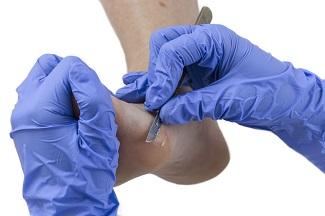Diabetic Foot Ulcer Care and Patient Support
March 31, 2020
Diabetic foot ulcer (DFU) complications are challenging and costly. Evidence-based practice and advanced wound care technologies have the potential to maximize good outcomes and prevent ulcer recurrence, but ensuring that patients receive education on diabetes management and DFU prevention is also a vital step. Over time, people with unmanaged diabetes have increased chances of complications such as neuropathy, peripheral vascular disease (PVD), chronic DFUs, infections, osteomyelitis, amputation, and even death.1
The Importance of Patient Education
In the United States, approximately 5% of people with diabetes mellitus will develop chronic DFUs, whereas 1% will go on to require an amputation. Worldwide, there are between 9.1 and 26.1 million annual incidences of foot ulcers in persons with diabetes.2 Infection is the most common culprit for more than half of all amputations in people with diabetes mellitus. Wound chronicity and severity, severe ischemia, and advanced wound infection are key factors in limb amputation.3 People with diabetes can reduce the risk of diabetes-related complications by managing blood glucose levels, performing daily foot examinations, and adhering to ongoing physician checkups.
Health care professionals should use a holistic approach in planning care and know there are times when it may be necessary to think outside the box in developing a care plan for patients. Insurance payers, home care environment, and available resources are all factors to take into consideration during care planning.
Diabetic Foot Ulcer Prevention Through Education
Providing diabetes education to patients and caregivers is vital in reducing risks of complications and non-adherence. Discuss major risk factors leading to diabetic foot complications. Closing the gap in education for patients with diabetes will help minimize complications, infection rates, amputation, and death.
Utilizing various strategies in education and follow-up care is imperative. Include not only your patient in education, but also the family and caregivers as appropriate. Asking your patients questions during education sessions at every visit regarding foot health, medication management, healthy lifestyles, and footwear is one way to assess and keep your patient involved in their care. When providing education to your patients with diabetes, it is important to cover all of the following points:
- Diabetes management
- Medication management
- Nutrition – well-balanced diet, supplements
- Healthy lifestyles – smoking and alcohol consumption cessation, high-protein diet, vitamins, supplements
- Foot health – daily foot checks, footwear, annual screenings
- Follow-up – appointments, specialists, monitoring
- Wound care management
- Offloading techniques – footwear, devices
- Signs and symptoms of infection
- Dressing management – application, frequency
- Treatment options – advanced wound care, laboratory work, diagnostics, debridement, surgery, hyperbaric oxygen therapy
- Follow-up appointments – wound clinic, primary, vascular, infectious disease
The American Diabetes Association (ADA) has a variety of free resources and a comprehensive tool for foot assessment and preventive care. Topics include prevention, nutrition, weight management, and fitness.4 The ADA Diabetic Foot Risk Classifications table outlines priority, indications, timeline, and suggested follow-ups. Priority classifications are risk levels ranging from very low to urgent (e.g., the very low risk category consists of no loss of protective sensation or peripheral arterial disease, patient education, annual follow-up).3,4 Common indications warranting further follow-up include:
- Uncontrolled blood glucose levels
- Loss of protective sensation
- Peripheral arterial disease
- Vascular disease
- Presence of lower limb swelling or edema
- Foot deformity
- Prescriptive or accommodative footwear
- Neuropathic pain
- History of ulcer or amputation
- Open wound or ulcerative area with or without signs of infection
Conclusion
Health care professionals should strive to increase awareness, prevention, and continuity of care using ongoing education within their practice. Closing the gaps in education for both patients and health care professionals will help minimize hospital admission, re-admissions, and diabetic ulcer wound chronicity across the continuum. Working as a multidisciplinary team will provide a moving force in DFU care and patient support.
References
1. Singer AJ, Tassiopoulos, Kirsner RS. Evaluation and management of lower-extremity ulcers. N Engl J Med. 2018;378(3):302-303.
2. Armstrong DG, Boulton AJM, Bus SA. Diabetic foot ulcers and their recurrence. N Engl J Med. 2017;376(24):2367-2375.
3. Boulton AJM, Armstrong DG, Kirsner RS, et al. Diagnosis and Management of Diabetic Foot Complications. Arlington, VA: American Diabetes Association; 2018.
4. American Diabetes Association. Tools to know your risk. https://www.diabetes.org/diabetes-risk/tools-know-your-risk. 2020. Accessed March 16, 2020.
The views and opinions expressed in this blog are solely those of the author, and do not represent the views of WoundSource, HMP Global, its affiliates, or subsidiary companies.












Follow WoundSource
Tweets by WoundSource